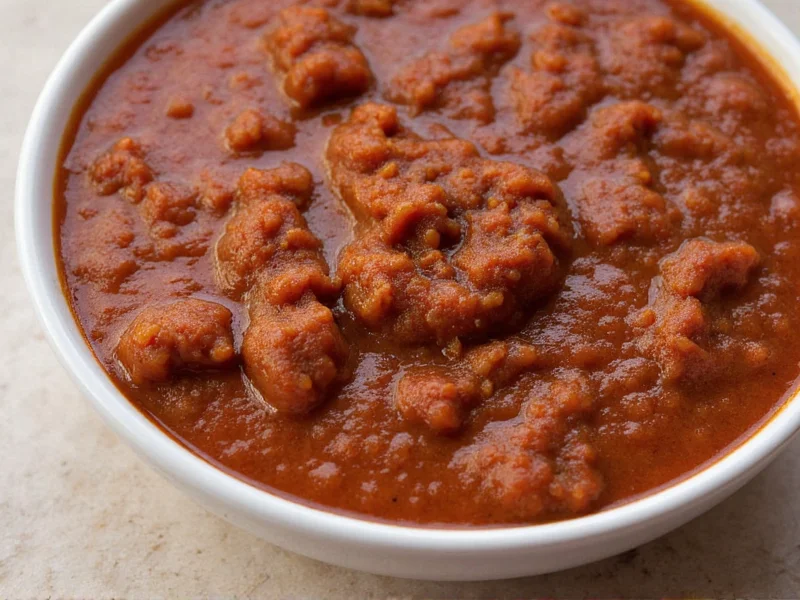Mexican mole stands as one of the country's most iconic culinary creations, embodying centuries of cultural fusion. The term \"mole\" derives from the Nahuatl word \"molli,\" meaning \"sauce\" or \"concoction,\" reflecting its complex nature. Contrary to common misconception outside Mexico, mole refers exclusively to the sauce, not the animal, and represents a cornerstone of Mexican gastronomy with regional variations across the country.
Historical Origins of Mole
The creation of mole traces back to pre-Hispanic Mexico, where indigenous peoples combined native ingredients like chiles, tomatoes, and seeds. Following the Spanish conquest, new ingredients including spices, nuts, and chocolate were incorporated, creating the complex sauces recognized today. Historical accounts suggest mole poblano emerged in Puebla during the colonial period, with legends attributing its creation to nuns at the Santa Rosa convent who combined available ingredients to honor a visiting archbishop.
Core Ingredients That Define Authentic Mole
Authentic mole requires careful balancing of multiple components. While recipes vary significantly by region and family tradition, most authentic moles contain:
- Multiple varieties of dried chiles (ancho, pasilla, mulato)
- Spices (cumin, cloves, cinnamon)
- Nuts and seeds (almonds, peanuts, sesame seeds)
- Tomatoes or tomatillos
- Garlic and onions
- Chocolate (in specific varieties like mole poblano)
- Breadcrumbs or tortillas for thickening
The preparation process remains labor-intensive, typically involving toasting, grinding, and slow simmering to develop the sauce's characteristic depth. Traditional preparation uses a molcajete (mortar and pestle) or metate (grinding stone), though modern cooks often employ blenders.
| Mole Variety | Region of Origin | Key Characteristics | Distinctive Ingredients |
|---|---|---|---|
| Mole Poblano | Puebla | Dark reddish-brown, slightly sweet | Chocolate, ancho/pasilla/mulato chiles |
| Mole Negro | Oaxaca | Very dark, complex flavor | Charred chiles, burnt tortilla, chocolate |
| Mole Coloradito | Oaxaca | Reddish color, moderately sweet | Guajillo chiles, plantain, sesame seeds |
| Mole Verde | Central Mexico | Bright green, herbaceous | Pumpkin seeds, tomatillos, cilantro, green chiles |
| Mole Amarillo | Oaxaca | Yellow color, mild heat | Guajillo chiles, hoja santa, tomatoes |
Regional Variations Across Mexico
Mexico's diverse regions have developed distinctive mole varieties, each reflecting local ingredients and traditions. Oaxaca alone claims seven traditional moles, earning it the nickname \"land of the seven moles.\" While mole poblano remains the most internationally recognized, regional specialties like Oaxacan mole negro (notably darker and more complex than mole poblano) and mole verde (a fresh, herb-based version) demonstrate the sauce's versatility.
The preparation methods also vary significantly. Some regions emphasize toasting ingredients extensively to develop deeper flavors, while others focus on fresh ingredients. The number of ingredients can range from a dozen to over thirty components, depending on the specific recipe and family tradition.
Common Misconceptions About Mole
Several misconceptions surround Mexican mole, particularly among those unfamiliar with authentic preparation. The most persistent myth suggests chocolate dominates mole's flavor, when in reality it serves as a subtle background note that balances the chiles' heat and acidity. Authentic mole recipes use unsweetened chocolate that contributes richness rather than sweetness.
Another common confusion involves the difference between mole and guacamole. Despite the similar names, guacamole (from \"ahuacamolli\" - avocado sauce) contains no chocolate and features avocado as its primary ingredient. The shared \"-molli\" suffix simply indicates both are sauces in Nahuatl.
Cultural Significance and Traditional Serving Methods
Mole holds deep cultural significance in Mexico, often prepared for special occasions including weddings, baptisms, and national holidays. The labor-intensive preparation traditionally involved entire families working together, with each member responsible for specific tasks. In many regions, the recipe represents a closely guarded family secret passed through generations.
Traditionally, mole accompanies poultry, particularly turkey or chicken, served over rice with warm tortillas on the side. The sauce's complexity makes it a centerpiece of the meal rather than a simple condiment. In Oaxaca, mole often appears at celebrations alongside other regional specialties like tlayudas and memelas.
Modern Interpretations and Global Influence
While traditional preparation remains cherished, contemporary chefs have developed innovative interpretations of mole. Some create simplified versions for home cooks, while others experiment with non-traditional ingredients while respecting the sauce's fundamental structure. Mole's influence has spread globally, appearing in fusion dishes from mole-infused chocolates to mole-inspired barbecue sauces.
Despite these modern adaptations, authentic mole preparation continues to honor its cultural roots. The growing appreciation for traditional Mexican cuisine has led to increased recognition of mole's complexity and cultural importance worldwide, with many chefs emphasizing the importance of understanding its history alongside its preparation.











 浙公网安备
33010002000092号
浙公网安备
33010002000092号 浙B2-20120091-4
浙B2-20120091-4